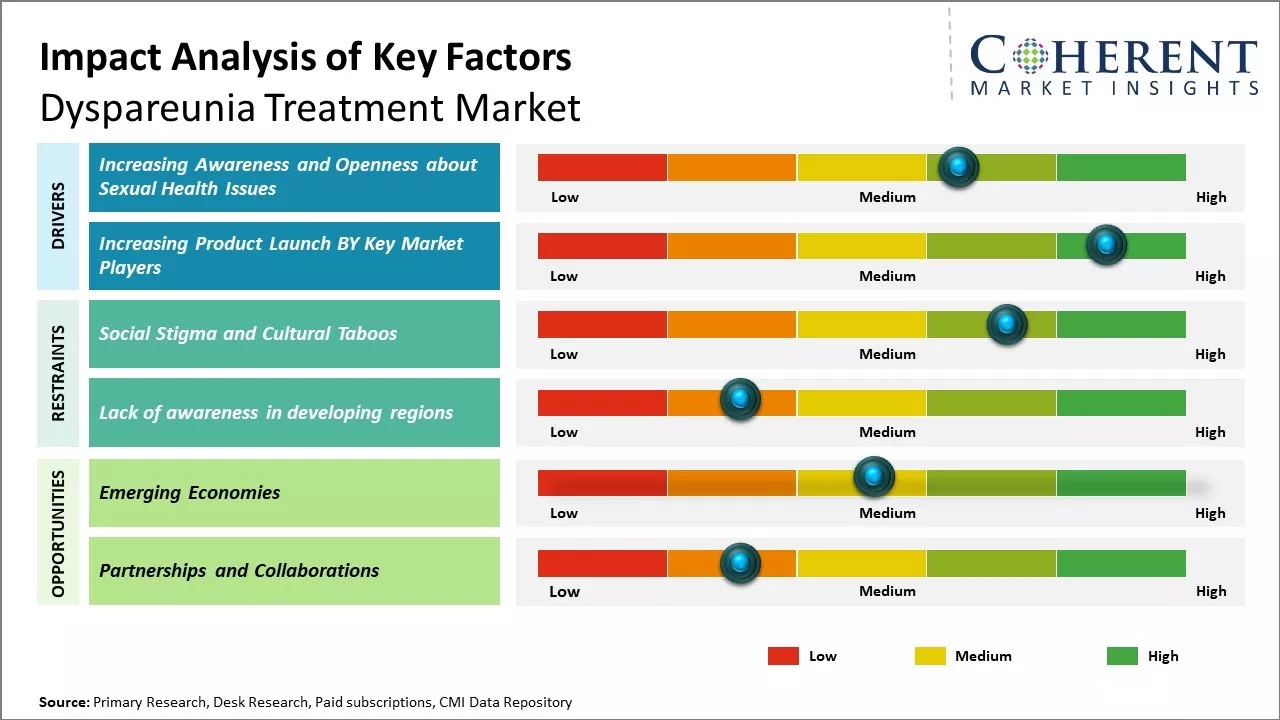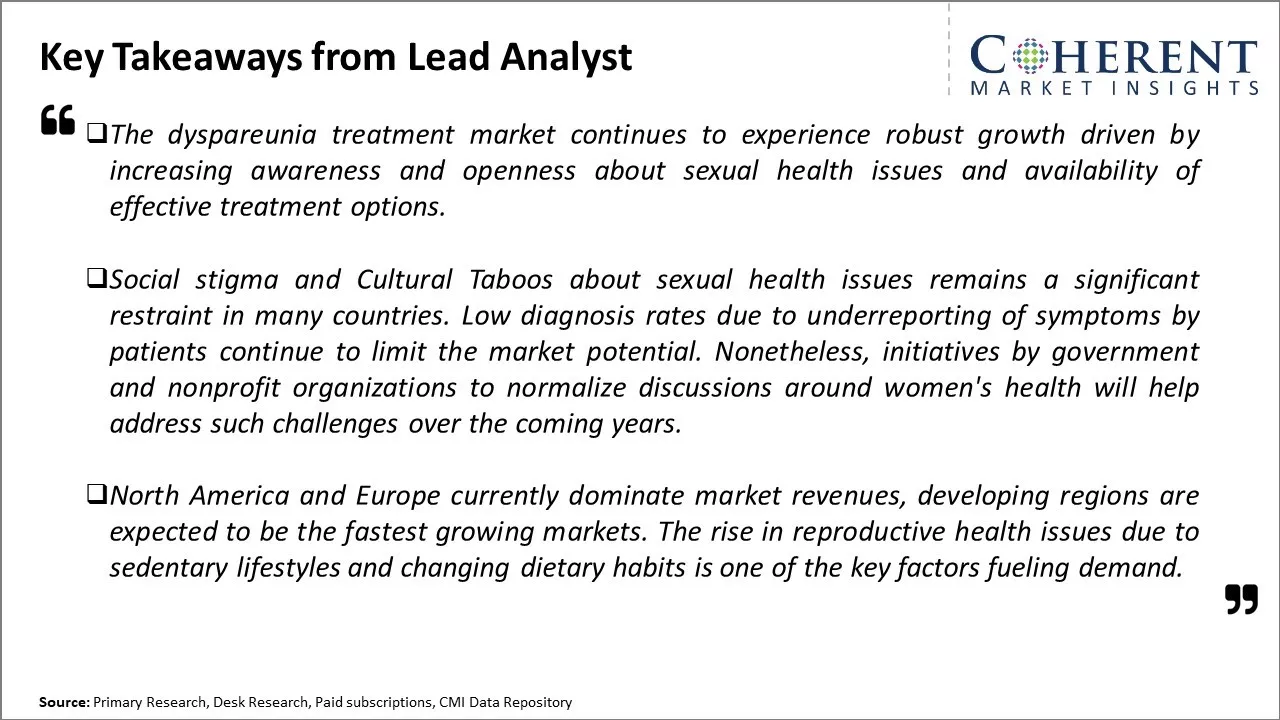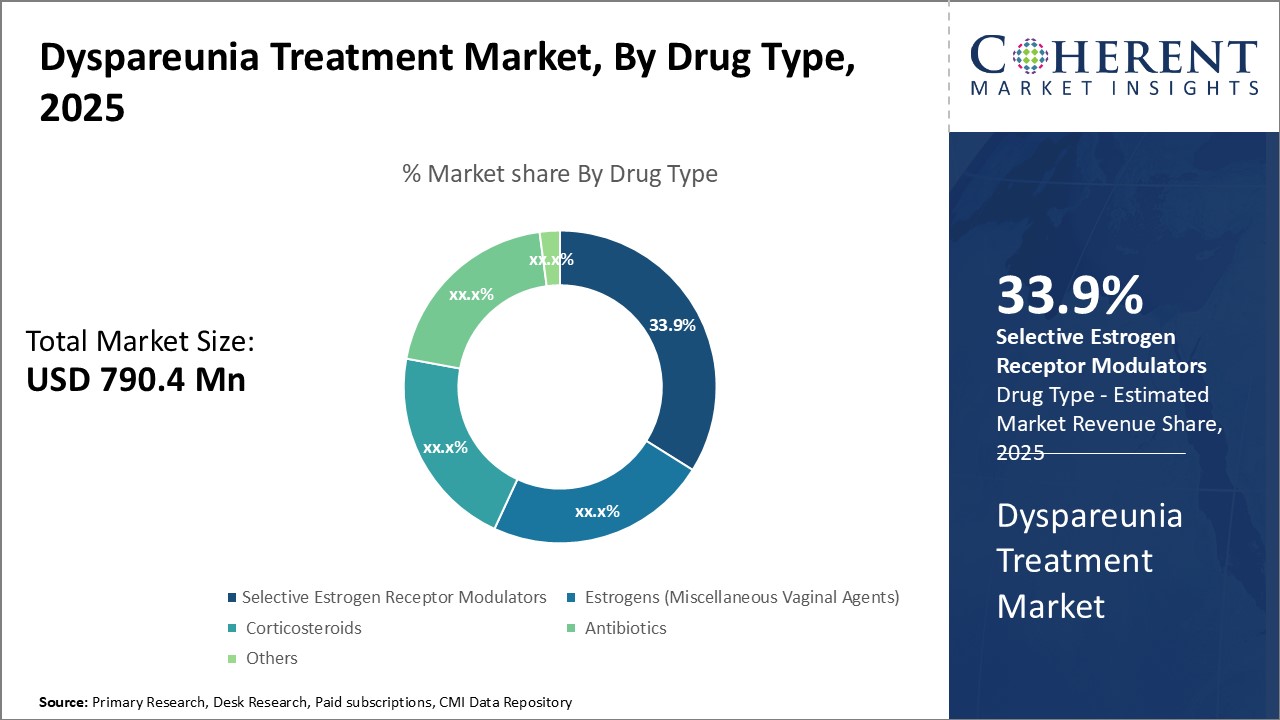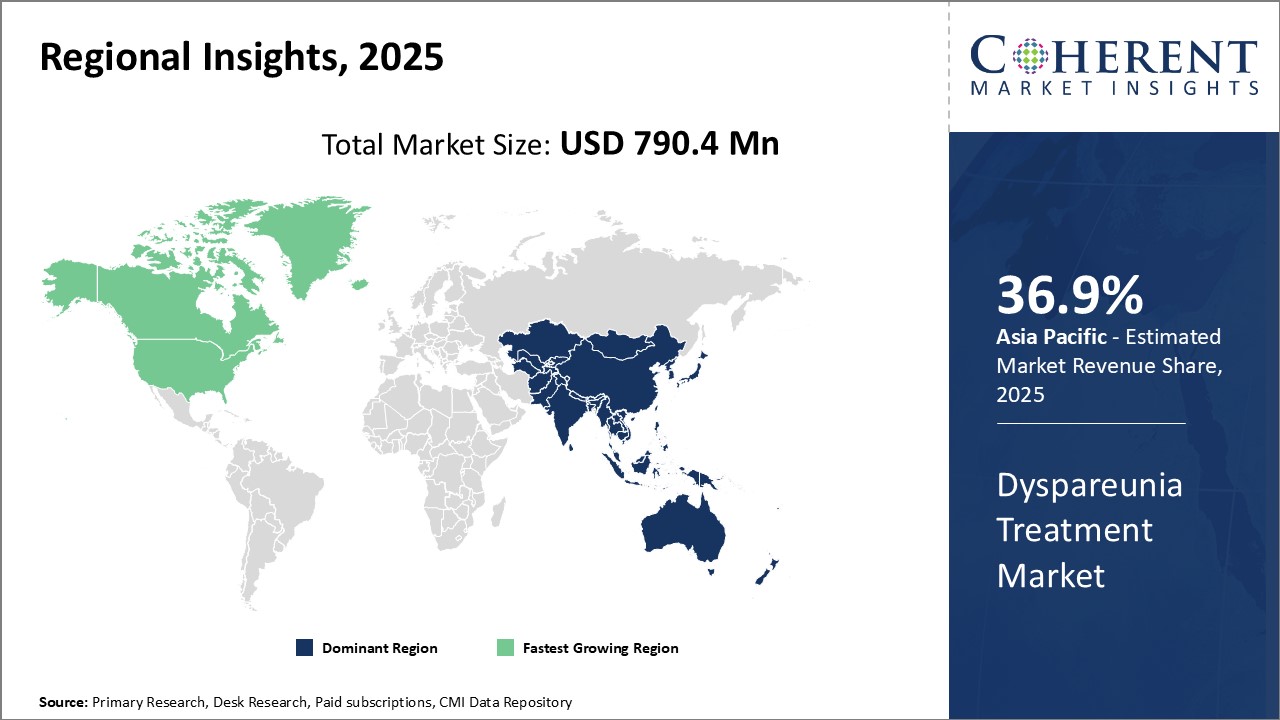Dyspareunia Treatment Market Size and Trends
The dyspareunia treatment market is estimated to be valued at USD 790.4 Mn in 2025 and is expected to reach USD 1,098.1 Mn by 2032, exhibiting a compound annual growth rate (CAGR) of 4.8% from 2025 to 2032.

Discover market dynamics shaping the industry: Download Free Sample
The dyspareunia treatment market has been witnessing positive trends with growing focus on developing new and more effective therapeutics. While topical drugs continue to hold the largest share currently, the segments of oral therapies and medical devices are expected to offer lucrative opportunities with ongoing research on drug delivery methods and minimally invasive procedures. Successful new product launches addressing the unmet needs can further accelerate market expansion over the forecast period.
Increasing Awareness and Openness about Sexual Health Issues
Growing societal acceptance and open discussions around female sexuality and sexual health issues have significantly boosted awareness about dyspareunia in recent times. Not too long ago, female sexual pains and dysfunctions were brushed under the carpet due to stigma and conservatism. However, with more women coming forward to share their experiences, dyspareunia is no longer a hidden problem. Several influencers on social media who are sexual wellness advocates have ramped up conversations around sexuality. Their efforts have played a big role in assuaging misconceptions and guilt surrounding such issues. Women have started understanding that they are not alone in experiencing genital pain during or after intercourse and it is not a result of physical abnormality or their moral weakness. The taboo around sexual health issues is now slowly dissipating. More women feel empowered to seek help rather than tolerate pain in silence. Several non-profit organizations are active in creating public awareness campaigns and seminars to educate people about sexual wellness. The medical community too has become more responsive and sensitive while addressing such problems. Gynecologists and general physicians nowadays are able to carefully diagnose and reassure women rather than dismiss their concerns. Overall, the paradigm shift towards a healthier and open treatment of sexuality on both social and medical fronts has motivated dyspareunia sufferers to explore treatment options. The stigma lift has enabled earlier diagnosis and management of the condition.
Market Concentration and Competitive Landscape

Get actionable strategies to beat competition: Download Free Sample
Increasing Product Launches by Key Market PlayersIncreasing adoption of organic growth strategies, such as product launches, by key market players for the treatment of dyspareunia are expected to drive the market growth over the forecast period. For instance, in February 2022, Duchesnay Inc., a global pharmaceutical company, announced that it had launched Osphena (ospemifene tablets), a Selective Estrogen Receptor Modulator (SERM) in Canada for the treatment of vaginal dryness and dyspareunia. Osphena has been shown in phase II and III clinical studies to treat moderate to severe dyspareunia (painful intercourse) and/or vaginal dryness in postmenopausal women, which are symptoms of vulvar and vaginal atrophy (VVA), a component of genitourinary syndrome of menopause (GSM).

To learn more about this report, Download Free Sample
Market Challenges – Social Stigma and Cultural TaboosThe dyspareunia treatment market faces several challenges in growth. Due to social stigma and cultural taboos associated with discussing intimacy issues, many women do not report symptoms or seek treatment for dyspareunia. This poses difficulties for pharmaceutical companies and medical technology firms to appropriately assess the size of the market and develop solutions. Further challenges include lack of awareness among healthcare providers and limited funding for medical research into novel therapies.
Market Opportunities – Emerging Economies
The emerging economies could present significant opportunities for growth in the dyspareunia treatment market. Countries, such as India, China, Brazil and others that are witnessing rapid development and urbanization are now able to afford newer treatment options. As awareness levels rise regarding health and wellness in these societies, more women are willing to seek medical help for issues like dyspareunia. This is creating a demand for novel drugs and therapies that can help in the effective management of pain during sexual intercourse. The increasing presence of global pharmaceutical companies in these regions through local partnerships and contract manufacturing is ensuring wider availability of advanced treatment methods.

Discover high revenue pocket segments and roadmap to it: Download Free Sample
Insights, By Drug Type: Drug Efficacy Drives the Selective Estrogen Receptor Modulators SegmentThe drug type segment includes growth selective estrogen receptor modulators, estrogens (miscellaneous vaginal agents), corticosteroids, antibiotics, and others. The selective estrogen receptor modulators segment is estimated to hold 33.9% share of the market in 2025 owing to their high efficacy in dyspareunia treatment. Selective estrogen receptor modulators (SERMs) work by blocking the effects of estrogen in the vagina and vulva, which helps reduce pain. Among the available SERMs, ospemifene is preferred by most physicians and patients due to its favorable safety and tolerability profile. Ospemifene works by restoring tissue elasticity and thickness in the vaginal lining which improves vaginal dryness, a major cause of dyspareunia. It provides relief within 4 weeks of treatment and symptoms continue to improve with prolonged use. The drug is also convenient being available in the form of once-daily oral tablets. These compelling benefits of SERMs over other drug types have made it the treatment of choice for a large percentage of dyspareunia patients. Additionally, increased education and awareness among doctors regarding ospemifene's mechanism of action driving its high efficacy is also propelling the growth of this segment.
Insights, By Route of Administration: Patient Centric Approach Favors Oral Administration
The route of administration segment includes oral, vaginal inserts, and others. The oral sub-segment is expected to have 36.9% of the market share in 2025 due to its patient-centric approach. Oral drugs provide instant relief from pain during intercourse by restoring hydration and elasticity in the vaginal tissues. They are also more convenient than other administration methods as pills can be taken discreetly without any physical examination or application process. This helps in overcoming the embarrassment or anxiety that some patients may experience with vaginal therapies or inserts. The non-invasive nature of oral drugs further helps improve compliance. Among the oral drugs available, ospemifene has revolutionized the treatment paradigm with its once-daily dosing and significant symptomatic relief. Its high efficacy is encouraging more patients and physicians to opt for oral SERMs over other local therapies. Furthermore, increasing awareness about dyspareunia as a medical condition is encouraging more patients to seek medical help through convenient oral treatments instead of tolerating the pain silently.
Insights, By Distribution Channel: Retail Accessibility Augments Retail Pharmacies Segment
The distribution channel segment includes retail pharmacies, hospital pharmacies, e-commerce, and others. The retail pharmacies sub-segment is expected to have 38.4% of the market share in 2025 owing to their widespread access and convenience. Retail pharmacies allow patients to directly purchase over-the-counter topical therapies or prescription drugs with a valid prescription at their own convenience without needing an appointment. This provides instant relief especially during unexpected episodes of pain. Their presence across both urban and rural areas also ensures treatments are available to a huge patient population. The self-care and family care sections in retail stores further raise awareness about available management options. Importantly, retail pharmacies offer discretion and privacy to patients who may feel uncomfortable discussing sensitive issues like dyspareunia with pharmacists at hospitals. The cost-effectiveness of retail channels also makes therapy more affordable for many. With rising acceptability of dyspareunia as a medical condition requiring attention, retail pharmacies will continue sprouting new growth avenues in this market segment.
Regional Insights

Need a Different Region or Segment? Download Free Sample
North America remains the dominant region in the global dyspareunia treatment market and is anticipated to hold 36.9% of the market share in 2025. North America has historically dominated the global dyspareunia treatment market owing to several favorable factors. Being an early adopter of new therapies, the region is home to many leading pharmaceutical and medical device companies that have driven innovations in pain management. North American women also have greater awareness about sexual health issues and are more willing to seek medical help for conditions like dyspareunia. The large per capita healthcare expenditure and well-developed healthcare infrastructure in countries like the U.S. and Canada have further facilitated wide availability and adoption of various prescription medications and medical devices approved for dyspareunia. Local manufacturing and R&D capabilities enable North American companies to cater to domestic demand well and provide timely product support. This has given them a competitive edge over companies from other regions trying to establish themselves in the North America dyspareunia market. The Asia Pacific region has emerged as the fastest growing market for dyspareunia treatments. With rising incomes and growing health insurance coverage in developing nations, more women are now able to access medical care for improving sexual wellness. Their growing health consciousness is a major driver of the market growth. Some Asia Pacific countries like China and India also have a large population base suffering from dyspareunia due to the high prevalence of gynecological issues. This vast untapped patient pool is attracting many international and local pharmaceutical manufacturers to introduce affordable drugs and devices in these markets through partnerships with domestic distributors. Favorable trade policies are also facilitating import of treatments from other regions. Increased regional collaboration on clinical research is further helping expand treatment options and reduce costs. With continued economic and healthcare sector expansion, the Asia Pacific region is poised to dominate the global dyspareunia treatment market in the long run.
Market Report Scope
Dyspareunia Treatment Market Report Coverage
| Report Coverage | Details | ||
|---|---|---|---|
| Base Year: | 2024 | Market Size in 2025: | USD 790.4 Mn |
| Historical Data for: | 2020 To 2024 | Forecast Period: | 2025 To 2032 |
| Forecast Period 2025 to 2032 CAGR: | 4.8% | 2032 Value Projection: | USD 1,098.1 Mn |
| Geographies covered: |
|
||
| Segments covered: |
|
||
| Companies covered: |
Lupin, Pfizer Inc., AbbVie Inc., Duchesnay Inc., AMAG Pharmaceuticals, Inc., Amneal Pharmaceuticals LLC., TherapeuticsMD, Inc., Sumitomo Pharma Co., Ltd., Myovant Sciences, Novo Nordisk A/S, Viatris Inc., Shionogi & Co., Ltd., Millicent Pharma Ltd., Cosette Pharmaceuticals, Inc., and Mundipharma International |
||
| Growth Drivers: |
|
||
| Restraints & Challenges: |
|
||
Uncover macros and micros vetted on 75+ parameters: Get instant access to report
Dyspareunia Treatment Industry News
- In December, 2023, DARÉ BIOSCIENCE, INC., a pharmaceutical company, announced that the U.S. Food and Drug Administration has cleared an investigational new drug (IND) application for DARE-VVA1, a tamoxifen currently being developed as a non-hormone therapy to be administered intravaginally in patients with moderate to severe dyspareunia, which often presents in menopausal patients with vulvar and vaginal atrophy (VVA). Tamoxifen is a selective estrogen receptor modulator often used to treat breast cancer, acting as an estrogen antagonist in breast tissue.
- In June 2023, Cosette Pharmaceuticals, Inc., a pharmaceutical company, announced the acquisition of the global rights to Intrarosa, from Endoceutics, Inc., a subsidiary of Endorecherche, Inc., a pharmaceutical company. Intrarosa is the only prescription drug providing both estrogen and androgen for the treatment of moderate-to-severe dyspareunia (a common symptom of vulvar and vaginal atrophy (VVA) due to menopause).
- In October 2021, Debiopharm, a biopharmaceutical company, Dexa Medica, a leading Indonesia-based pharmaceutical company, announced the launch of triptorelin in Indonesia for the treatment of women with gynecological disorders, particularly endometriosis.
*Definition: Dyspareunia is a term that refers to painful sexual intercourse due to medical or psychological causes. It encompasses both female dyspareunia and male dyspareunia, with the female type being more common. Many factors can raise the risk of painful intercourse. They include illnesses, surgeries and other medical treatments, and mental health issues.
Market Segmentation
- Drug Type Insights (Revenue, USD Mn, 2020 - 2032)
- Selective Estrogen Receptor Modulators
- Estrogens (Miscellaneous Vaginal Agents)
- Corticosteroids
- Antibiotics
- Others
- Route of Administration Insights (Revenue, USD Mn, 2020 - 2032)
- Oral
- Vaginal Inserts
- Others
- Distribution Channel Insights (Revenue, USD Mn, 2020 - 2032)
- Retail Pharmacies
- Hospital Pharmacies
- E-commerce
- Others
- Regional Insights (Revenue, USD Mn, 2020 - 2032)
- North America
- U.S.
- Canada
- Latin America
- Brazil
- Argentina
- Mexico
- Rest of Latin America
- Europe
- Germany
- U.K.
- Spain
- France
- Italy
- Russia
- Rest of Europe
- Asia Pacific
- China
- India
- Japan
- Australia
- South Korea
- ASEAN
- Rest of Asia Pacific
- Middle East
- GCC Countries
- Israel
- Rest of Middle East
- Africa
- South Africa
- North Africa
- Central Africa
- North America
- Key Players Insights
- Lupin
- Pfizer Inc.
- AbbVie Inc.
- Duchesnay Inc.
- AMAG Pharmaceuticals, Inc.
- Amneal Pharmaceuticals LLC.
- TherapeuticsMD, Inc.
- Sumitomo Pharma Co., Ltd.,
- Myovant Sciences
- Novo Nordisk A/S
- Viatris Inc.
- Shionogi & Co., Ltd.
- Millicent Pharma Ltd.
- Cosette Pharmaceuticals, Inc.
- Mundipharma International
Share
Share
About Author
Vipul Patil is a dynamic management consultant with 6 years of dedicated experience in the pharmaceutical industry. Known for his analytical acumen and strategic insight, Vipul has successfully partnered with pharmaceutical companies to enhance operational efficiency, cross broader expansion, and navigate the complexities of distribution in markets with high revenue potential.
Missing comfort of reading report in your local language? Find your preferred language :
Transform your Strategy with Exclusive Trending Reports :
Frequently Asked Questions
EXISTING CLIENTELE
Joining thousands of companies around the world committed to making the Excellent Business Solutions.
View All Our Clients
